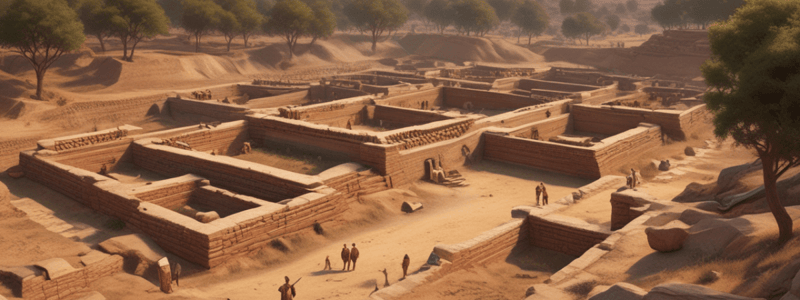Podcast
Questions and Answers
Based on the evidence from Harappa, which of the following statements is most accurate regarding the early Harappan phase?
Based on the evidence from Harappa, which of the following statements is most accurate regarding the early Harappan phase?
- There was a division into distinct areas or mounds with platforms and fortifications. (correct)
- The settlement lacked any semblance of planning or organization.
- The layout of houses and streets followed a completely random pattern.
- Mud-brick construction was not utilized for any structures.
Which of the following types of artifacts were not found in the early Harappan phase at Harappa?
Which of the following types of artifacts were not found in the early Harappan phase at Harappa?
- Stone celts
- Terracotta female figurines
- Chert blades
- Copper tools (correct)
According to the information provided, which of the following statements is true regarding the Cholistan region during the early Harappan phase?
According to the information provided, which of the following statements is true regarding the Cholistan region during the early Harappan phase?
- There was a complete absence of specialized craft activities.
- It had the highest concentration of Kot Dijian sites. (correct)
- The transition from nomadic life to permanent settlement was gradual.
- It was devoid of any human settlements.
Based on M.R. Mughal's study, what percentage of sites during the Hakra wares phase were camp sites?
Based on M.R. Mughal's study, what percentage of sites during the Hakra wares phase were camp sites?
Which of the following statements accurately describes the size distribution of settlements during the Kot Dijian phase in the Cholistan region?
Which of the following statements accurately describes the size distribution of settlements during the Kot Dijian phase in the Cholistan region?
Which of the following artifacts found in the early Harappan phase at Harappa continued into the mature Harappan phase?
Which of the following artifacts found in the early Harappan phase at Harappa continued into the mature Harappan phase?
What are some common elements found in the distinctive pottery of Period I at Kot Diji?
What are some common elements found in the distinctive pottery of Period I at Kot Diji?
Which site showed a clear transition from the early Harappan to a transitional and then mature Harappan phase?
Which site showed a clear transition from the early Harappan to a transitional and then mature Harappan phase?
What is the dominant pottery type found in Period II at Sarai Khola?
What is the dominant pottery type found in Period II at Sarai Khola?
What were some of the stone tools found at Tarakai Qila?
What were some of the stone tools found at Tarakai Qila?
What plant remains were identified at Rehman Dheri?
What plant remains were identified at Rehman Dheri?
Where was a factory site found where various kinds of stone tools were made?
Where was a factory site found where various kinds of stone tools were made?
What evidence suggests links with the Indus valley by the end of Period VII at Mehrgarh?
What evidence suggests links with the Indus valley by the end of Period VII at Mehrgarh?
What animal bones were identified in the early Harappan levels at Rehman Dheri?
What animal bones were identified in the early Harappan levels at Rehman Dheri?
Which period at Gumla in the Gomal valley belonged to the mature Harappan phase?
Which period at Gumla in the Gomal valley belonged to the mature Harappan phase?
What types of beads were found in the industrial area at Lewan?
What types of beads were found in the industrial area at Lewan?
What is the approximate distance of Amri from the right bank of the Indus River?
What is the approximate distance of Amri from the right bank of the Indus River?
Which of the following is NOT a characteristic of Period I at Amri?
Which of the following is NOT a characteristic of Period I at Amri?
What was the primary purpose of the multiple cellular compartments found in Period IC at Amri?
What was the primary purpose of the multiple cellular compartments found in Period IC at Amri?
What was the primary method of pottery decoration used during Period I at Amri?
What was the primary method of pottery decoration used during Period I at Amri?
What was the primary building material used in the house walls found in the upper levels at Kot Diji?
What was the primary building material used in the house walls found in the upper levels at Kot Diji?
What is the approximate date range for the Early Harappan Period I at Kot Diji?
What is the approximate date range for the Early Harappan Period I at Kot Diji?
Flashcards are hidden until you start studying
Study Notes
Early Harappan Phase Overview
- Early Harappan artifacts reflect a distinct cultural phase with varying characteristics from the mature Harappan period.
- Some types of artifacts not found in the early Harappan phase include advanced metallurgy and certain specialized tools.
Cholistan Region Insights
- The Cholistan region during the early Harappan phase exhibited a range of settlements characterized by their spatial organization and resources.
- Notable demographic and trade patterns suggest regional connectivity with neighboring cultures during this phase.
Hakra Wares Phase Findings
- M.R. Mughal's study indicates that camp sites made up approximately 70% of the findings during the Hakra wares phase.
Size Distribution of Settlements
- Settlement sizes during the Kot Dijian phase in the Cholistan region show a predominant pattern of smaller communities, indicating social stratification.
Artifacts Transition to Mature Harappan Phase
- Specific artifacts from the early Harappan phase at Harappa that continued into the mature phase include distinct pottery styles and standardized weights.
Kot Diji Pottery Characteristics
- Distinctive pottery in Period I at Kot Diji often displays intricate designs and usage of natural pigments, reflecting early artistic expression.
Transitioning Sites
- The site that shows a clear transition from the early Harappan to transitional and mature phases is Kot Diji.
Dominant Pottery at Sarai Khola
- The dominant pottery type found in Period II at Sarai Khola includes painted wares with geometric motifs.
Stone Tools at Tarakai Qila
- At Tarakai Qila, various stone tools were found, including microliths and larger choppers, indicative of specialized production techniques.
Plant Remains at Rehman Dheri
- Identified plant remains at Rehman Dheri include grains such as barley and pulses, showcasing agricultural practices.
Stone Tool Factory
- A factory site was discovered at Chandigarh, where various forms of stone tools were manufactured, illustrating organized production.
Indus Valley Links at Mehrgarh
- Evidence by Period VII at Mehrgarh suggests increasing links with the Indus Valley, based on trade items and cultural exchange.
Animal Bones at Rehman Dheri
- Animal bones found in early Harappan levels at Rehman Dheri include cattle and sheep, indicating domestication and pastoral practices.
Gumla and the Mature Harappan Phase
- The period at Gumla in the Gomal Valley that corresponds to the mature Harappan phase is marked by advanced urban planning and resource management.
Beads Found at Lewan
- The industrial area at Lewan yielded a variety of beads made from semiprecious stones, highlighting craftsmanship and trade networks.
Amri Distance from Indus River
- Amri is located approximately 25 kilometers from the right bank of the Indus River, influencing its trade dynamics.
Amri Period I Characteristics
- A notable characteristic NOT associated with Period I at Amri is the absence of palatial structures, suggesting a different social organization.
Period IC at Amri Compartments
- The multiple cellular compartments in Period IC at Amri primarily served for storage and possibly for social gatherings.
Pottery Decoration Method at Amri
- The primary method of pottery decoration used during Period I at Amri was incising and painting with mineral-based pigments.
Building Material at Kot Diji
- The primary building material used for house walls in upper levels at Kot Diji was mud bricks, reflecting architectural practices.
Early Harappan Period I Date Range
- The approximate date range for Early Harappan Period I at Kot Diji is around 3300 to 2600 BCE, marking a critical developmental phase.
Studying That Suits You
Use AI to generate personalized quizzes and flashcards to suit your learning preferences.




